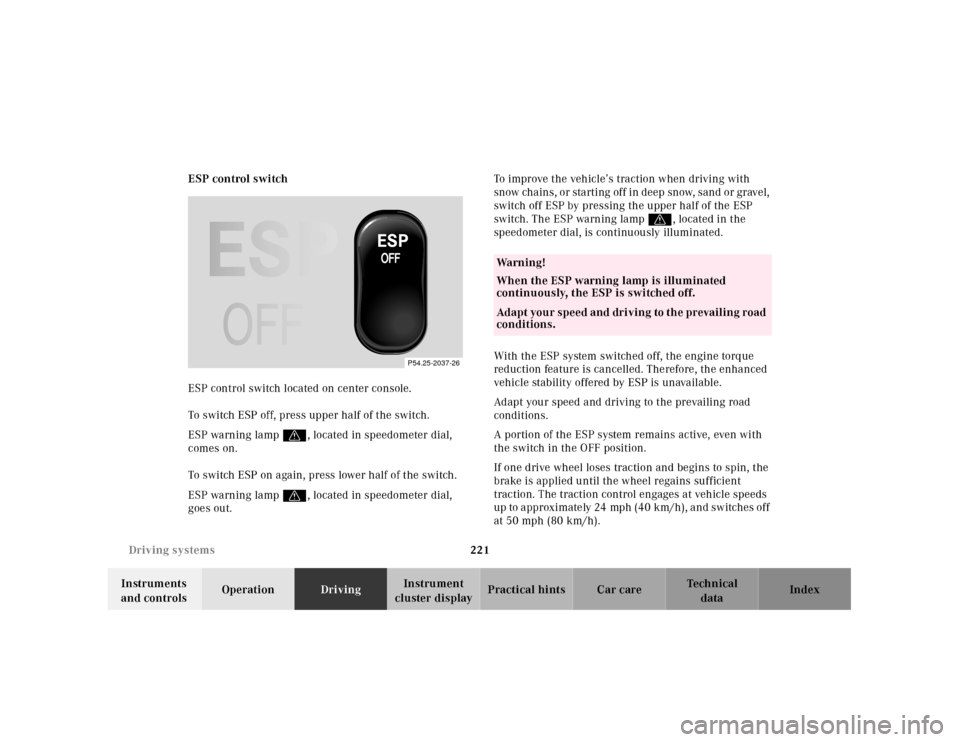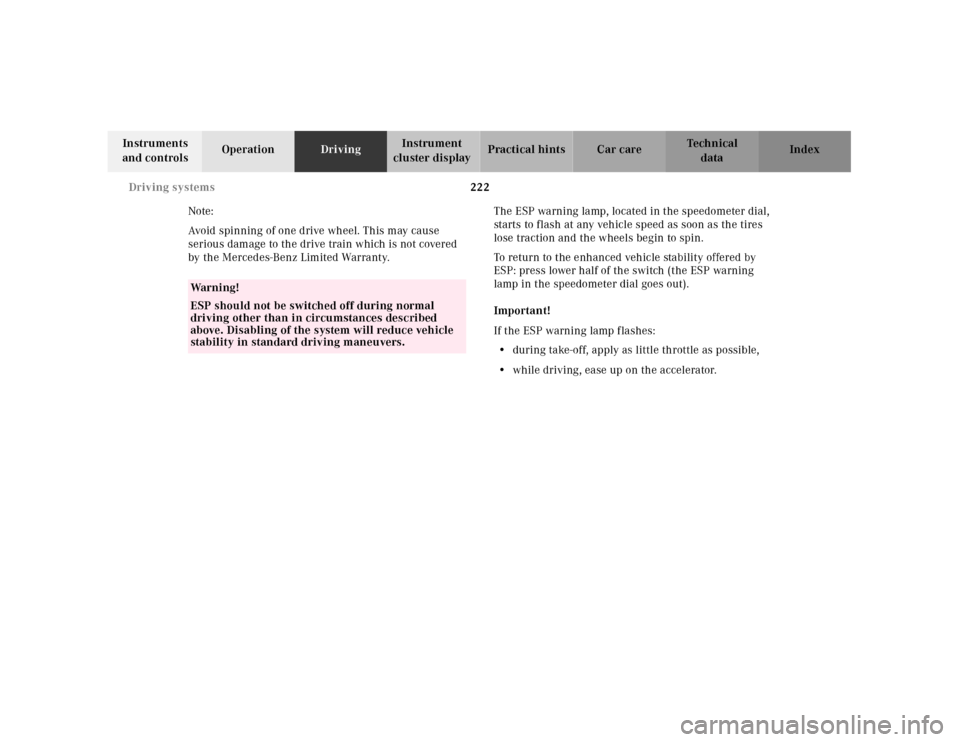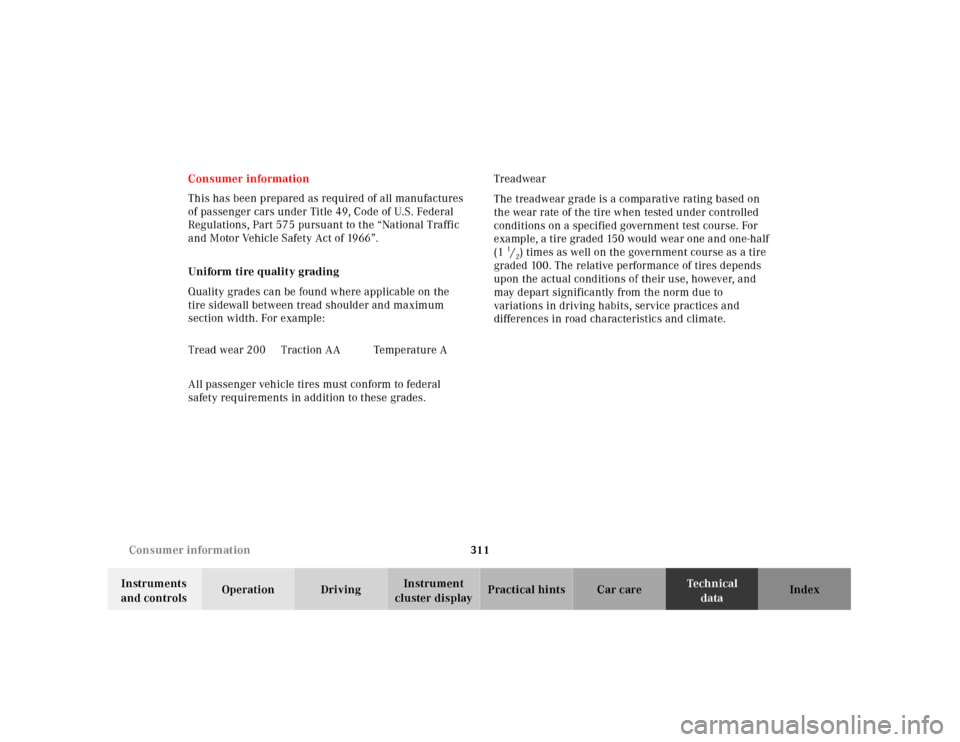2001 MERCEDES-BENZ CLK55AMG traction control
[x] Cancel search: traction controlPage 222 of 329

219 Driving systems
Te ch n ica l
data Instruments
and controlsOperationDrivingInstrument
cluster displayPractical hints Car care Index Electronic stability program (ESP)
The ESP enhances directional control and reduces
driving wheel spin of the vehicle under various driving
conditions.
Over/understeering of the vehicle is counteracted by
applying brakes to the appropriate wheel to create a
countervailing vehicle movement. Engine torque is also
limited. The ESP warning lamp, located in the
speedometer dial, starts to flash when ESP is in
operation.Important!
If the ESP warning lampv flashes:
•During take-off apply as little throttle as possible.
•While driving ease up on the accelerator.
•Adapt your speed and driving to the prevailing road
conditions.
•Do not switch off the ESP.
Caution!
If the vehicle is towed with the front axle raised (see
towing the vehicle on page 272), the engine must be
shut off (electronic key in steering lock position 0 or 1).
Otherwise, the ESP will immediately be engaged and
will apply the rear wheel brakes.
Wa r n i n g !
ESP cannot prevent the natural laws of physics
from acting on the vehicle, nor can it increase the
traction afforded. The ESP cannot prevent
accidents, including those resulting from excessive
speed in turns, or aquaplaning. Only a safe,
at tentive, and ski llful driver can prevent ac cidents.
The capabilities of an ESP equipped vehicle must
never be exploited in a reckless or dangerous
manner which could jeopardize the user’s safety or
the safety of others.
Page 224 of 329

221 Driving systems
Te ch n ica l
data Instruments
and controlsOperationDrivingInstrument
cluster displayPractical hints Car care Index ESP control switch
ESP control switch located on center console.
To switch ESP off, press upper half of the switch.
ESP warning lampv, located in speedometer dial,
comes on.
To switch ESP on again, press lower half of the switch.
ESP warning lampv, located in speedometer dial,
goes out.To improve the vehicle’s traction when driving with
snow cha ins, or sta rting of f in deep snow, sand or gravel,
switch off ESP by pressing the upper half of the ESP
switch. The ESP warning lampv, located in the
speedometer dial, is continuously illuminated.
With the ESP system switched off, the engine torque
reduction feature is cancelled. Therefore, the enhanced
vehicle stability offered by ESP is unavailable.
Adapt your speed and driving to the prevailing road
conditions.
A portion of the ESP system remains active, even with
the switch in the OFF position.
If one drive wheel loses traction and begins to spin, the
brake is applied until the wheel regains sufficient
traction. The traction control engages at vehicle speeds
up to approximately 24 mph (40 km/h), and switches off
at 50 mph (80 km/h).
P54.25-2037-26
Wa r n i n g !
When the ESP warning lamp is illuminated
continuously, the ESP is switched off. Adapt you r speed and dri ving to th e prevailing road
conditions.
Page 225 of 329

222 Driving systems
Te ch n ica l
data Instruments
and controlsOperationDrivingInstrument
cluster displayPractical hints Car care Index
Note:
Avoid spinning of one drive wheel. This may cause
serious damage to the drive train which is not covered
by the Mercedes-Benz Limited Warranty.The ESP warning lamp, located in the speedometer dial,
starts to flash at any vehicle speed as soon as the tires
lose traction and the wheels begin to spin.
To return to the enhanced vehicle stability offered by
ESP: press lower half of the switch (the ESP warning
lamp in the speedometer dial goes out).
Important!
If the ESP warning lamp flashes:
•during take-off, apply as little throttle as possible,
•while driving, ease up on the accelerator.
Wa r n i n g !
ESP should not be switched off during normal
driving other than in circumstances described
above. Disabling of the system will reduce vehicle
stability in standard driving maneuvers.
Page 314 of 329

311 Consumer information
Te ch n ica l
data Instruments
and controlsOperation DrivingInstrument
cluster displayPractical hints Car care Index Consumer information
This has been prepared as required of all manufactures
of passenger cars under Title 49, Code of U.S. Federal
Regulations, Part 575 pursuant to the “National Traffic
and Motor Vehicle Safety Act of 1966”.
Uniform tire quality grading
Quality grades can be found where applicable on the
tire sidewall between tread shoulder and maximum
section width. For example:
All passenger vehicle tires must conform to federal
safety requirements in addition to these grades.Treadwear
The treadwear grade is a comparative rating based on
the wear rate of the tire when tested under controlled
conditions on a specified government test course. For
example, a tire graded 150 would wear one and one-half
(1
1/2) times as well on the government course as a tire
graded 100. The relative performance of tires depends
upon the actual conditions of their use, however, and
may depart significantly from the norm due to
variations in driving habits, service practices and
differences in road characteristics and climate.
Tread wear 200 Traction AA Temperature A
Page 315 of 329

312 Consumer information
Te ch n ica l
data Instruments
and controlsOperation DrivingInstrument
cluster displayPractical hints Car care Index
Traction
The traction grades, from highest to lowest are AA, A, B,
and C. Those grades represent the tire’s ability to stop
on wet pavement as measured under controlled
conditions on specified government test surfaces of
asphalt and concrete. A tire marked C may have poor
traction performance.Te mp e r a t u r e
The temperature grades are A (the highest), B, and C,
representing the tire’s resistance to the generation of
heat and its ability to dissipate heat when tested under
controlled conditions on a specified indoor laboratory
test wheel. Sustained high temperature can cause the
material of the tire to degenerate and reduce tire life,
and excessive temperature can lead to sudden tire
failure. The grade C corresponds to a level of
performance which all passenger vehicle tires must
meet under the Federal Motor Vehicle Safety Standard
No. 109. Grades B and A represent higher levels of
performance on the laboratory test wheel than the
minimum required by law.
Wa r n i n g !
The traction grade assigned to this tire is based on
straightahead braking traction tests, and does not
include acceleration, cornering, hydroplaning, or
peak traction characteristics.
Wa r n i n g !
The temperature grade for this tire is established
for a tire that is properly inflated and not
overloaded. Excessive speed, underinflation, or
excessive loading, either separately or in
combination, can cause excessive heat build up
and possible tire failure.
Page 325 of 329

322 Index
Te ch n ica l
data Instruments
and controlsOperation DrivingInstrument
cluster displayPractical hints Car careIndex
Storage compartments,
armrest and cup holder ............................................ 153
Stowing things in the vehicle ......................................248
Sun visors ....................................................................... 152
Supplemental restraint system (SRS) ........................... 66
Synchronizing remote control .....................................285
TTachometer ....................................................................... 89
Technical data ................................................................ 301
Electrical system .......................................................303
Main dimensions ......................................................304
Rims and tires ...........................................................302
Weights .......................................................................304
Tele Aid ........................................................................... 180
Emergency calls ........................................................ 181
Information ................................................................ 185
Initiating an emergency call manually ................. 183
Roadside Assistance ................................................. 184
TELE AID - malfunction
and warning messages ............................................246
Telephone .......................................................................... 98
General notes ............................................................. 164
Incoming call ............................................................. 102Redialing ....................................................................100
Telephone book ........................................................... 98
Telephones and two-way radios ................................... 176
Telescoping steering column
Adjusting ......................................................................78
Indicator lamp .......................................................... 232
Telescoping steering column - malfunction
and warning messages ............................................ 242
The first 1 000 miles .....................................................177
Tire inflation pressure ................................................. 267
Tire traction ................................................................... 207
Tires ................................................................................. 311
Driving instructions ................................................ 206
Rims and tires .......................................................... 302
Rotating wheels ........................................................ 260
Tire inflation pressure ............................................ 267
Tire replacement ...................................................... 259
Winter driving instructions .................................... 209
Tow-away alarm ................................................................44
Towing the vehicle ........................................................ 272
Transmission .................................................................. 193
Transmission selector lever,
manually unlocking .................................................. 274
Traveling abroad ............................................................ 211
Trip computer .................................................................104
Trip odometer ...................................................................89